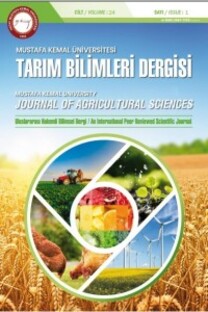Estimation of monthly precipitation based on machine learning methods by using meteorological variables
___
Anonymous, (2012) Chaharmahal and Bakhtiari Meteorological Administration. Retrieved June 26, 2019, from https://www.chaharmahalmet.ir/ .Anonymous, (2016) Water challenges of Iran. Retrieved June 16, 2019, from https://water.fanack.com/iran/water-challenges-ofiran/ .
Asghari K, Nasseri M (2014) Spatial rainfall prediction using optimal features selection approaches. Hydrol. Res. 46 (3): 343-355.
Bostan PA, Heuvelink GB, Akyurek SZ (2012) Comparison of regression and kriging techniques for mapping the average annual precipitation of Turkey. Int. J. Appl. Earth. Obs. 19: 115-126.
Breiman L (2001) Random Forests. Mach. Learn. 45(1): 5- 32.
Bushara NO (2016) Rainfall forecasting in Sudan using computational inteligence. PhD Thesis, Sudan University of Science and Technology, 177 p.
Eyvazi M, Mosaedi A (2012) An investigation on spatial pattern of annual precipitation in Golestan province by using deterministic and geostatisticcs model. J. Water Soil, 26 (1): 53-64.
Hall MA (1999) Correlation-based feature selection for machine learning. PhD Thesis, University of Waikato, Department of Computer Science, 178 p.
Ji SY, Sharma S, Yu B, Jeong DH (2012) Designing a rulebased hourly rainfall prediction model. IEEE 13th International Conference on Information Reuse & Integration (IRI). pp. 303-308.
Khandelwal N, Davey R (2012) Climatic assessment of Rajasthan’s region for drought with concern of data mining techniques. Int. J. Eng. Res. App. 2 (5): 1695- 1697.
Olaiya F, Adeyemo AB (2012) Application of data mining techniques in weather prediction and climate change studies. Int. J. Inf. Eng. Elec. Bus. 4 (1): 51.
Sethi N, Garg K (2014) Exploiting data mining technique for rainfall prediction. Int. J. of Comp. Sci. Information Tech. 5 (3): 3982-3984.
Sharif MH, Burn D (2006) Simulating climate change scenarios using an improved K-nearest neighbor model. J. Hydrol. 325: 179-196.
Sivaramakrishnan TR, Meganathan S (2012) Point rainfall prediction using data mining technique. Res. J. Ap. Sci. Eng. Tech. 4 (13): 1899-1902.
Wang ZL, Sheng HH (2010) Rainfall prediction using generalized regression neural network: case study Zhengzhou. International conference on computational and information sciences. pp. 1265- 1268.
Zaw WT, Naing TT (2008) Empirical statistical modeling of rainfall prediction over Myanmar. W. Acad. Sci., Eng. Techn. 2 (10): 500-504.
- ISSN: 1300-9362
- Yayın Aralığı: 3
- Başlangıç: 1996
- Yayıncı: Mustafa Kemal Üniversitesi Ziraat Fakültesi
Ferhat AVCI, OĞUZHAN ÇALIŞKAN, Fulya UZUNOĞLU
Engin GÖNEN, Çağatay TANRIVERDİ, Yeşim BOZKURT ÇOLAK, Attila (ve diğerleri) Yazar, Mete ÖZFİDANER
Rania SOULA, Ali CHEBIL, Mahmut CETIN, Rajouene MAJDOUB
Memiş KESDEK, Ayşe USANMAZ BOZHÜYÜK, Şaban KORDALİ
TR63 bölgesi iklim koşullarının seracılık açısından irdelenmesi
A. Nafi BAYTORUN, Adil AKYÜZ, Ali ÇAYLI, Sait ÜSTÜN
Hatay ilinde ışık tuzağı ile belirlenen cicadellidae familyası türleri ve popülasyon yoğunlukları
Kamuran KAYA, Hüseyin BAŞPINAR
Hüseyin T. GÜLTAŞ, Yeşim AHİ, Daniyal D. KÖKSAL, Murat KARAER
Muhammer DÜNDAR, Mustafa AĞAHAN ÜNLÜ, Celal YÜCEL ARİFE AVAĞ
